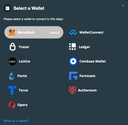Moonbeam: The EVM of Polkadot
Deploying and onboarding users to Moonbeam or Moonriver
We've covered several Layer 2 sidechains before:
But Moonbeam is unique since it's a parachain of the Polkadot ecosystem. It only just launched which means you are now able to deploy smart contracts to the chain. Being able to deploy EVM contracts to the Polkadot world comes with unique features.

What is Moonbeam?
Moonbeam is a Polkadot parachain. Rather than regular sidechains, a parachain in Polkadot has unique security benefits. It can take advantage of the Polkadot chain's security. This shared security mechanism can greatly decrease the risk for 51% attacks like happened for Ethereum Classic attack on January 10. Parachains can also make use of Cross-Consensus Message Format (XCM) which allows to send messages from one parachain to another one. And yes you can use tokens transferred via XCM in your smart contracts!
And you can send regular Ethereum transactions to Moonbeam. Moonbeam has implemented a fully functioning EVM as part of a Polkadot parachain. The EVM is fully functioning with most precompiles and all opcodes available. But since Moonbeam itself is a Proof of Stake chain, some opcodes have no meaning in Moonbeam. If you are reading things like the block hash or difficulty, it will only return some default values.
The available precompiles and additionally deployed helper contracts can be found here. In particular Moonbeam specific features include:
- Parachain Staking: You can interact with the parachain staking directly by (un-)-delegating and retrieving rewards.
- Crowdloan Rewards: You can retrieve crowdloan information as well as claim rewards.
- Wrapped GLMR as ERC-20: 0xAcc15dC74880C9944775448304B263D191c6077F
All code for Moonbeam can be found here. And block explorers either with Moonbeam Blockscout or Moonscan.
Why choose Moonbeam?
Since Moonbeam is a Polkadot parachain, deploying smart contracts to it will have a much higher security than deploying to other sidechains. The Polkadot relay chain has a very large market cap currently being in the Top 10 of all chains. And with Moonbeam you can take full advantage of the speed, Proof of Stake and low gas fees without having to compromise on the security aspect.
And you can make use of new features!
Parachain Staking
You can directly access staking features using the ParachainStaking interface contract at address 0x0000000000000000000000000000000000000800.
This will allow you to delegate funds directly to the Moonbeam parachain staking from Proof of Stake within your smart contract.
- You can use the
delegatefunction to start a delegation to parachain node (called collator). - You can use
schedule_leave_delegatorsto stop a delegation.
There are a few other functions in the interface which you can see here, but the ones on the right will be the most important ones.
// SPDX-License-Identifier: GPL-3.0-only
pragma solidity >=0.8.0;
interface ParachainStaking {
function is_delegator(
address delegator
) external view returns (bool);
function is_candidate(
address candidate
) external view returns (bool);
function delegate(
address candidate,
uint256 amount,
uint256 candidateDelegationCount,
uint256 delegatorDelegationCount
) external;
function schedule_leave_delegators() external;
}Crowdloan Rewards
And you can also access crowdloan rewards to get info or to claim rewards for any crowdloan participant. The interface is available at address 0x0000000000000000000000000000000000000801.
If you're wondering what the heck is a crowdloan? The short answer is there is a limited amount of parachain slots available since every parachain increases the computational complexity of nodes in the Polkadot chain. That's why there are auctions for the slots as 2-year leasings. Whoever bids the most DOT will receive the slot for two years, while having their DOT locked during this time. A crowdloan then is a mechanism that most projects are using to collectively use DOT together and participants will receive the project's token as reward.
In the case of Moonbeam crowdloan participants received 30% initially and the rest is vested of a two year time with rewards being able to be claimed continuously.
You can see past, current and future auctions here. As you can see Moonbeam actually won the second auction right after Acala.
interface CrowdloanRewards {
function is_contributor(
address contributor
) external view returns (bool);
function reward_info(
address contributor
) external view returns (uint256, uint256);
function claim() external;
function update_reward_address(
address new_address
) external;
}XCM Tokens
Since Moonbeam is a parachain in Polkadot, you can make use of the cross-chain transfers. Inside your contracts you cannot directly transfer send XCM messages, because the EVM has no functionality for this. (although I imagine the Moonbeam EVM could get an upgrade to support this later?)
But you can still use cross-chain tokens. Moonbeam makes them automatically available as fully compatible ERC-20 tokens. If you wanted to do cross-chain transfers yourself, you will need to use the Moonbeam Substrate API. What is Substrate you may ask?
Substrate is a framework for developing your own blockchain as part of the Polkadot ecosystem. So Moonbeam itself was developed using this framework. And while Moonbeam provides an abstraction layer to be EVM compatible, under the hood the blockchain is managed in Substrate. So to use native Substrate features, you need to move out of the EVM abstraction. You can find a block explorer for the Substrate part of Moonbeam here.
Moonbeam vs. Moonriver: Which one to choose?
One unique feature of the Polkadot ecosystem is that they have a so-called canary chain: Kusama. It's the same chain as Polkadot except that they are more experimental (hence the name canary) by doing everything faster. For example governance time is shorter, unstaking period is shorter and the parachain auctions for Kusama started already half a year ago. And that's why some projects have two parachains, one on Kusama and one on Polkadot. In the case of Moonbeam, there is also the Moonriver parachain with the connection to Kusama. So which one should you use?
Moonriver will be the faster upgrading, more experimental chain with less security. For your own Dapp on Moonbeam you have three options:
- Deploy only to Moonbeam: higher security, more stable, longer time for upgrades
- Deploy only to Moonriver: lower security, less stable, faster time for upgrades
- Deploy to Moonbeam and Moonriver: highest security, since you will have your own canary Dapp this way, but more effort to maintain
Which option you choose is up to you. If you're unsure, you're probably best to deploy only to Moonbeam since it gives you high security without extra work.

Moonbeam Ecosystem
There is a large ecosystem evolving around Moonbeam. You can find many tools and projects currently working towards integrating Moonbeam. Many are at the time of writing still work in progress for Moonbeam. For example the Band and Chainlink oracles are not yet available, although Chainlink is available for Moonriver.
You can already use The Graph on Moonbeam. Check out my tutorial how to use it here. It's the best tool for querying blockchain data in your Dapp's frontend.
And if you're looking to integrate a DEX in your contracts like Uniswap, Solarflare is exactly that. If you want to integrate it, my previous Uniswap 2 tutorial should work just fine.

How to deploy to Moonbeam
Deploying to Moonbeam is very simple. If you're using Truffle or Hardhat, simply add the network configuration like this:
moonbeam: {
provider: () => new HDWalletProvider(mnemonic, 'https://rpc.api.moonbeam.network'),
network_id: 1284,
},
},
moonriver: {
provider: () => new HDWalletProvider(mnemonic, 'https://rpc.api.moonriver.network'),
network_id: 1285,
},
},
moonbase-alpha: {
provider: () => new HDWalletProvider(mnemonic, 'https://rpc.api.moonbase.moonbeam.network'),
network_id: 1287,
},
},You'll also need funds in the chain of course. For the testnet you can use the faucet via the faucet channel at the Moonbeam Discord. For Moonbeam and Moonriver funds, you'll need to purchase those on an exchange.
How to onboard users to your Moonbeam Dapp
1. Choice of wallet
These days you have much more than just MetaMask as possible wallets to support available. Take a look at Yearn Finance for example. They are supporting 11 different wallets alone at the time of this writing.


2. MetaMask example live in action
We'll focus on MetaMask as the biggest wallet with the most features. With MetaMask you can nowadays actually request to connect directly to a custom network.
If you want to see this live, just go to the Moonbeam docs. Unless you already have Moonbeam Network added, it will request to add this network.
3. How to add Moonbeam automatically for users
You can see on the right how to add the Moonbeam automatically to the wallet for the user. This will show the popup you see above. If the user confirms, the network is added and automatically switched to.
This is all thanks to EIP-3085 with the new RPC method wallet_addEthereumChain . See also the MetaMask docs here.
const params = [{
"chainId": "1284",
// Moonriver: "chainId": "1285",
// Testnet: "chainId": "1287",
"chainName": "Moonbeam",
// or "Moonriver" or "Moonbase Alpha"
"rpcUrls": [
"https://rpc.api.moonbeam.network"
// or "https://rpc.moonriver.moonbeam.network"
// or "https://rpc.api.moonbase.moonbeam.network"
],
"nativeCurrency": {
"name": "Glimmer", // or Moonriver or Dev
"symbol": "GLMR", // or MOVR or DEV
"decimals": 18
},
"blockExplorerUrls": [
"https://moonscan.io"
// or "https://moonriver.moonscan.io/"
// or "https://moonbase.moonscan.io/"
]
}]
try {
await ethereum.request({
method: 'wallet_addEthereumChain',
params,
})
} catch (error) {
// something failed, e.g., user denied request
}Solidity Developer